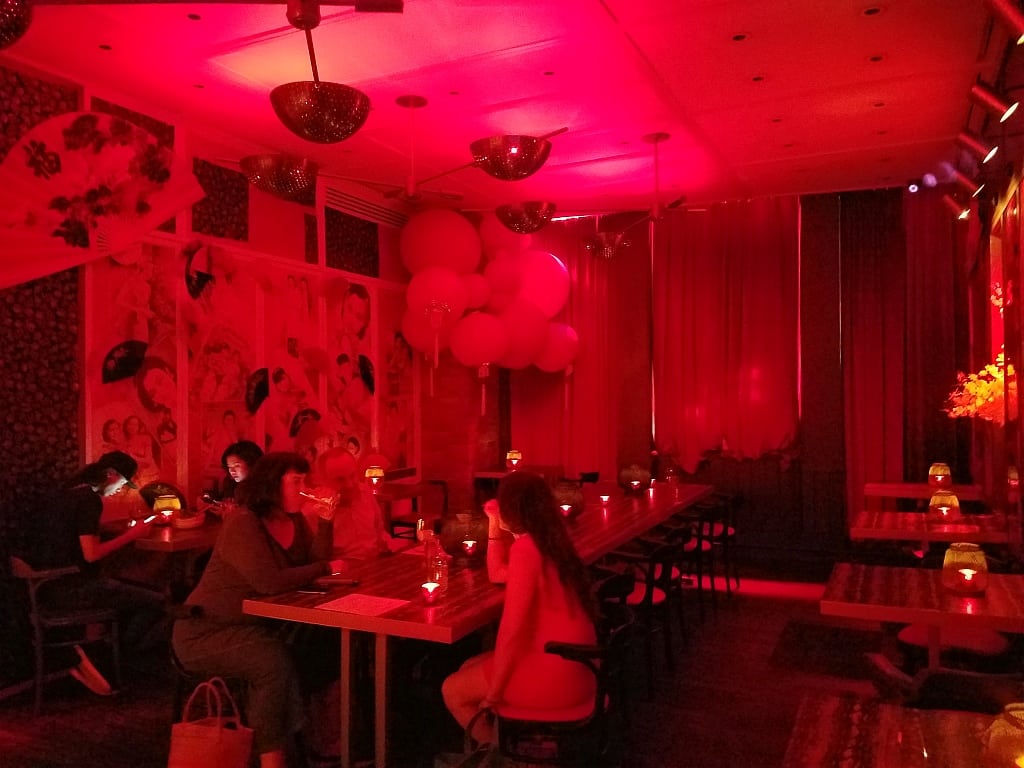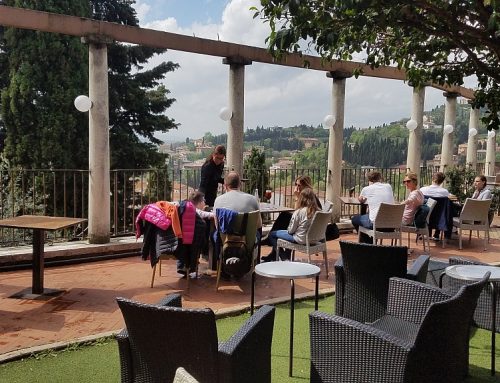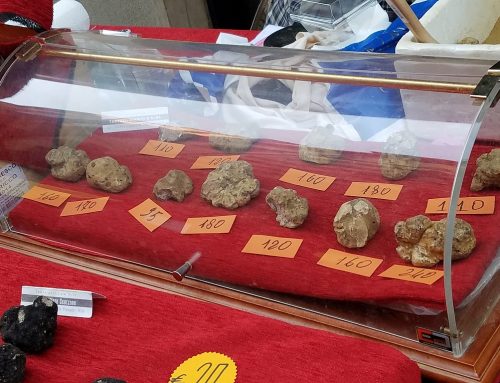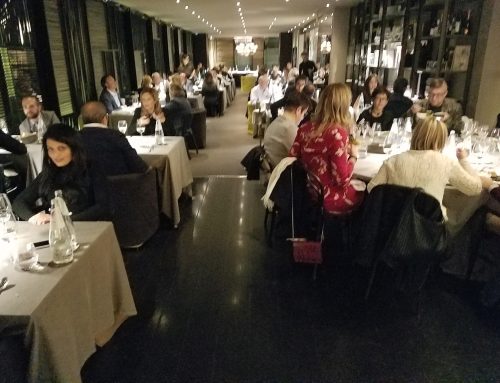Chef Abe Conlon was standing in the open kitchen as I walked past him and into the the private room of the Chef’s Club in Manhattan’s SoHo neighborhood.
Usually, the room is used for groups, wine tastings and other private affairs. But for Chef Conlon’s two-month residency, the restaurant converted it into a red-themed “The Ladies Room” where dim lights, and black and white pictures of women eyeing me from the paper panels made me feel I was doing something naughty just by being there.
The lounge offers cocktails and small bites before your dinner with the Portuguese-styled cuisine of Chicago’s acclaimed Chef Abe Conlon. I opted for a glass of the Portuguese sparkling 2016 Aphros, Phaunus, Pet Nat, Vinho Verde before trying to read Conlon’s menu. The low sexy red glow of the room suggested I should be doing something more sinful.
The seat at the kitchen counter is my favorite perch at the Chef’s Club. From there, I watch the new resident chef lead the club’s permanent kitchen crew. Conlon’s two-month gig, which ends October 13, marks the first year anniversary of the club’s residency program and my coverage of it.
From last October’s inaugural program with Chef JJ Johnson, I thought signing up top chefs for a limited engagement was a unique way to keep the restaurant exciting—not unlike Broadway’s use of great actors for a limited run. It also allows the chefs to present their best dishes, or try new creations as did the talented Chef Sota Atsumi whose term ended in July (perhaps using his New York residency as a focus group, if you will, for his new Paris restaurant, scheduled to open this fall).
Chef Conlon brings a new perspective through October 13. From his award-winning Fat Rice restaurant in Chicago, Conlon stitches together spices and foods of Portugal’s former colonies and his own heritage. Flavors from Brazil, Africa, India and Macau run through Conlon’s cooking—from the summery peaches with Iberico ham, basil and reduced Madeira vinegar, which I enjoyed with the Aphros sparkling wine, to peppery stuffed whole mackerel with coconut and cilantro by way of Goa, India. The coconut was not only tasty, it also helped smother the fire on my palate, which was finally extinguished by a glass of the white 2016 Quinta da Boavista, Rufia, a field blend of Portuguese grapes of the Dao region.
The sommelier created a list of Portuguese wines by the glass and bottle. Ordering by the glass will take you on a wine tour as adventurous as Conlon’s menu. My only disappointment was my first red wine: the 2015 Tiago Teles, Maria da Graca that was so warm it must have been in a hot storage room instead of a cool wine cellar or unit. But that was an easy fix: I ordered a glass of another red, requesting it be slightly chilled.
In Asia, eggplant is known as Brinjal, and Conlon’s treatment of it features limang, calamansi, peppery sambal and puffed rice coating the vegetable. It’s a very flavorful trip, but sensitive palates should keep the cold, Quinta da Boavista nearby.
Four prawns arrived surrounded by chilies and coated with a butter sauce (you can also order six). The large crustaceans were tender, tangy, and torrid, but a glass of the white 2015 Casa de Mouraz, Dao, answered the alarm.
Dessert brought the soothing Bebinca, a Goa multi-layered cake covered with a rich custard that Conlon served in a bright blue two-handled ramekin.
A week later, I sat at the bar sipping a glass of the nonvintage Filipa Pato 3B Rose Extra Brut sparkling wine. The 3Bs are for two indigenous Portuguese grapes, baga and bical, and the region in which they grow, Bairrada.
Its traditional-method fermentation—as in Champagne—produces a sparkling wine that is much different from the apple cider tasting Aphros Pet Nat (the trendy nickname for Petillant Naturel, a process that stops the fermentation before it’s complete, leaving a fizzy wine).
I was scanning the menu for less fiery foods when I saw Bachalhau. I had to order the salted cod, the unofficial national dish found on the menu of every restaurant I’ve been to in Portugal, and, I’m confident, in every family’s kitchen.
But I ordered it with a lack of enthusiasm as past plates were boring. Conlon overturned my viewpoint forever with his pureed cod’s brisk sea-water taste and slight chili kick, accompanied with tangy black olives. What I knew as a one-dimensional dish now climbed a ladder of flavors. And with the bachalhau, the Pato 3B Rose could also mean balanced beautiful bubbles.
The Po Kok Gai was the kind of stick-to-the ribs country food that I recall from my wine trips in Portugal. Served in a crock-pot, the chicken thighs commingled with delicious, slightly smoky chourico (chorizo), potatoes, black olives and Sao Jorge cheese from the Azores. Its richness was mirrored by my glass of the white 2017 Niepoort Redoma Reserva, made from a field blend of Portuguese white grapes from vines with an average age of 80 years.
For my final dish, I choose the chocolate mousse. It was the most unusual presentation with its chocolate cubes and squares of sweet wine gelatin. But once I got past the geometric presentation, the flavors captured my palate and more. My mind drifted to past residency chefs: Sota Atsumi’s frozen foie gras shavings that reminded me of milk chocolate, and JJ Johnson’s Afro spiced lamb suya whose goat yogurt cooled the kimchi slaw and expanded the Middle Eastern seasonings.
Not far from the Chef’s Club is the Public Theater. There you share a night with proven actors, experimental plays, inspiring writers. As it completes its first year run of resident chefs, the Chef’s Club is the culinary extension of that experience with its reputable chefs presenting their finest work and newest creations. Both are unique to New York; neither should be missed.
Photos by John Foy














Leave A Comment